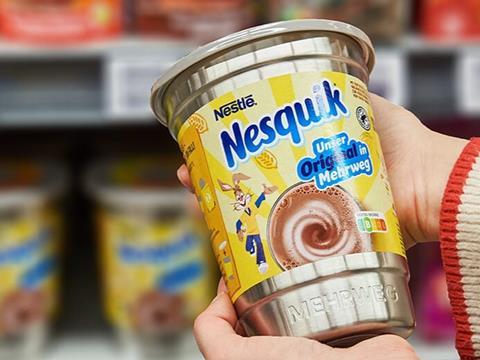
Nestlé lists a decrease in virgin plastic consumption, an uptake in recycled plastic content, its participation in reuse and refill trials, and its support of international legislation to combat waste among its steps towards more sustainable packaging practices in the last five years.
Nestlé has been a member of the Global Commitment on plastic waste since 2018 and, according to the Ellen MacArthur Foundation’s newest paper, it is among the top quartile brands and retailers group that have reduced their virgin plastic usage by an average of 13% and increased their products’ recyclability.
More specifically, the company itself claims to have cut down on its virgin plastic packaging by 10.5% and, in 2019, passed peak virgin plastic consumption and carbon emissions. It apparently remains on track to cut its use of virgin plastics by one third by the end of 2025 – pointing to the release of new Nescafé Dolce Gusto capsules last year, which constitute less plastic weight and are expected to save over 2,500 tonnes of polypropylene.
Reportedly, its total product packaging weight decreased by 200,000 tonnes in 2022, and its greenhouse gas emissions subsequently dropped by 280,000 tonnes. It is also said to have cut out 14 billion packaging pieces and cut its historic total packaging footprint down to 3.6 million metric tons compared to the 4.7 million metric tons in 2018.
Meanwhile, Nestlé has piloted over twenty refill and reuse pilots in twelve countries since 2018. For instance, its collaboration with circolution saw the roll-out of reusable stainless-steel containers for its Nesquik brand. It intends to keep testing reuse and refill solution across the world and pushing for the necessary conditions to enable them.
7.7% of its plastic packaging constituted recycled content by the end of last year. Now it aims to come close to 30% by the end of 2025, with Nestlé’s Buxton Natural Mineral Water transitioning into 100% recycled PET packaging in the UK to pursue this goal.
Currently, 81.9% of the company’s packaging is designed for recycling. This number is hoped to exceed 95% by the end of 2025 and eventually reach 100%.
However, where the necessary recycling infrastructure is absent, Nestlé is supporting its development and voicing its approval of a Global Plastics Treaty, effective deposit return systems, and improved Extended Producer Responsibility.
Nestlé has sought to develop well-functioning collection, sorting, and recycling schemes in Europe, Africa, Asia, and Latin America by partnering on 220 initiatives; this includes a door-to-door household waste collection programme in Malaysia. Approximately 6,000 tonnes of post-consumer waste had been collected, sorted, and traded by the end of 2022, which is thought to have almost eliminated waste going to landfill.
Now the company expresses its desire to keep packaging out of landfill and the environment and contribute to the packaging system transition.
“We are continually pursuing better packaging solutions where we can have a direct impact,” said Antonia Wanner, head of ESG Strategy and Deployment at Nestlé. “With our in-house packaging experts and scientists, we are developing the next generation of packaging materials as well as redesigning packaging for the circular economy.
“In addition, we promote better infrastructure systems for waste management, advocate for harmonized regulation, and encourage behavioural change.”
In a recent conversation with Packaging Europe, Christophe Boussemart, sustainability programme manager for Nespresso, and Nescafé Dolce Gusto’s Susanne Kulhanek discussed Nestlé’s plan to transition its single-serve coffee capsules into circularity.
Nestlé Česko is also working with PENNY and POSpooling to pilot point-of-sale stands made of wire and display its KOFILA chocolates. These alternatives are said to perform five times better than cardboard stands in terms of environmental burden.
If you liked this article, you might also enjoy:
The L’Oréal approach to packaging sustainability
What steps is Apple taking to make its packaging more sustainable?
How did Brazil achieve its 100% aluminium can recycling rate – and can it be replicated in the EU?
Experts have their say on the EU’s Packaging and Packaging Waste Directive revisions
Also, if you’re interested in packaging sustainability, you will want to attend our Sustainable Packaging Summit in Amsterdam on 14-15 November. The Summit brings together leaders and pioneers from across the industry to align strategically, learn, network, and create a critical mass to accelerate change. You can learn more by clicking here, and you can buy a ticket to attend here.


















No comments yet